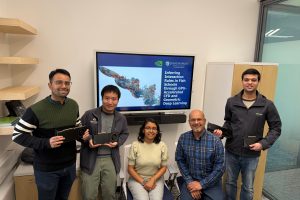
A team led by Rajat Mittal, professor of mechanical engineering and Somdatta Goswami, assistant professor of civil and systems engineering and affiliate of the Johns Hopkins Data Science and AI Institute, was recently granted four of the latest Blackwell graphics processing units (GPUs) by NVIDIA through the company’s academic grant program. The new GPUs will significantly expand the group’s ability to model the complex dynamics of fish schooling behavior.
The project aims to understand how individual fish coordinate to move as a collective. With increased computational power, the researchers plan to simulate much larger fish schools than previously possible and apply more sophisticated geometric deep learning models to infer patterns of “behavior” emerging from these simulations.
“If we can solve the mystery of how collective movement arises in animals such as fish, it would reveal the fundamental rules governing group coordination, shed light on ecological and evolutionary processes, and uncover neural and genetic mechanisms underlying social behavior,” Mittal said. “This equipment grant and the collaboration with NVIDIA will go a long way in helping us achieve that.”
In the current project, PhD students Sushrut Kumar and Ji Zhou use computational fluid dynamics (CFD) simulations to generate high-fidelity datasets based on video observations of real fish schools. Building on this foundation, PhD student Dibyajyoti Nayak employs state-of-the-art AI models to identify and interpret the patterns of the subtle coordination strategies that emerge within the school.
“Understanding collective behavior requires bridging physics, biology, and data-driven modeling,” Goswami said. “These GPUs will let us explore that bridge at a scale we simply couldn’t before. It opens up a new regime of simulations where emergent behavior becomes visible.”
Earlier, Mittal discovered that a school of fish is quieter than an individual fish, an insight that suggests efficiency and stealth advantages of collective behavior. However, the team’s progress was constrained by the available computing power, which restricted the duration of their simulations.
“The NVIDIA GPUs will allow us to increase, potentially by more than a hundredfold, the size of the fish schools we can model,” Mittal said.